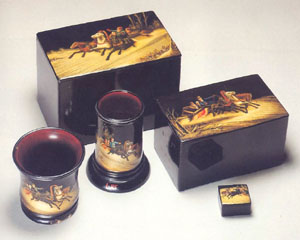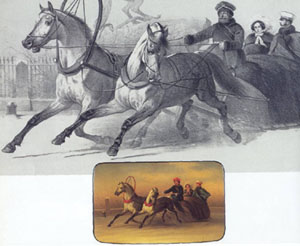In 1818, control of the Korobov workshop passed to Piotr Lukutin (Korobov's son-in-law) who expanded production to include tea caddies, album covers,desk accessories, and boxes for many different purposes. Artists began to hand paint intricate decorative motifs on the boxes, and these small paintings became status symbols among the aristocracy and wealthy merchant class. As demand for the lacquered papier-mâché items grew, so did the complexity of design and decoration. Just five years after Lukutin took over, the workshop employed over fifty skilled painters, and a school at the factory was training apprentices.
Piotr Lukutin began exhibiting his products in 1828 at industrial and handcraft fairs in Russia and Europe, winning public acclaim and many awards. It was this same year that Lukutin received the highest honor, a royal edict, allowing him to use the Imperial emblem of the double-headed eagle and his initials as the company trademark. Alexander Lukutin joined his father as factory manager in 1841, and together they transformed a simple craft into a genuine art form through daring innovation in subject-matter and technique.
|
The main competitor of the Lukutin workshop was the lacquer workshop of Osip Fillipovich Vishnyakov founded in the nearby village of Ostashkovo in the 1780s. Vishnyakov was a former serf freed from the Sheremetev Family Estate. Vishnyakov and his sons produced a variety of papier-mâché lacquer ware items including: snuffboxes, tea boxes, eyeglass cases, matchboxes, and Easter eggs. They sold their wares in Moscow at the various fairs and markets. This workshop flourished into the mid-1800s. The Vishnyakov and Lukutin workshops were in fierce competition and frequently their paintings depicted similar scenes such as the racing winter troika. Not only were such scenes popular, but some of the artists moved back and forth between the two workshops resulting in stylistic and thematic similarities in they items produced. The lacquer ware produced in this era was not signed by the artist, therefore it is nearly impossible to know who painted a specific piece. Most of the lacquer miniature paintings from this era were hand rendered reproductions of famous paintings and popular illustrations rather than being original compositions. However, these lacquer miniatures distinguished themselves from the works that inspired them due to the techniques used in their creation and the resulting depth and illumination in the painting. The techniques include the use of a primed papier-mâché surface with a background of metal powder over which several layers of thin oil paint were applied. In the mid-19th century the Vishnyakov workshop began production of lacquered metal trays. The production of painted metal trays, subsequently, branched into a separate industry centered in Zhostovo. The Lukutin workshop was finally closed in 1904 and some of the artists transferred to the Vishnyakov workshop. Many of the artists found the working conditions there unacceptable and in 1910 they banded together to form the Fedoskino Artel. |
 Products of the Vishnyakov workshops 1880s and 1890s |
SHOP for antique lacquer Russian American Company |
 Many early paintings were copied directly from popular prints.
Many early paintings were copied directly from popular prints.
Russian American Company 1-800-742-6228
Information about:
Lacquer Boxes Russian Dolls Russian Porcelain Russian Crystal
Faberge Jewelry Russian Christmas
